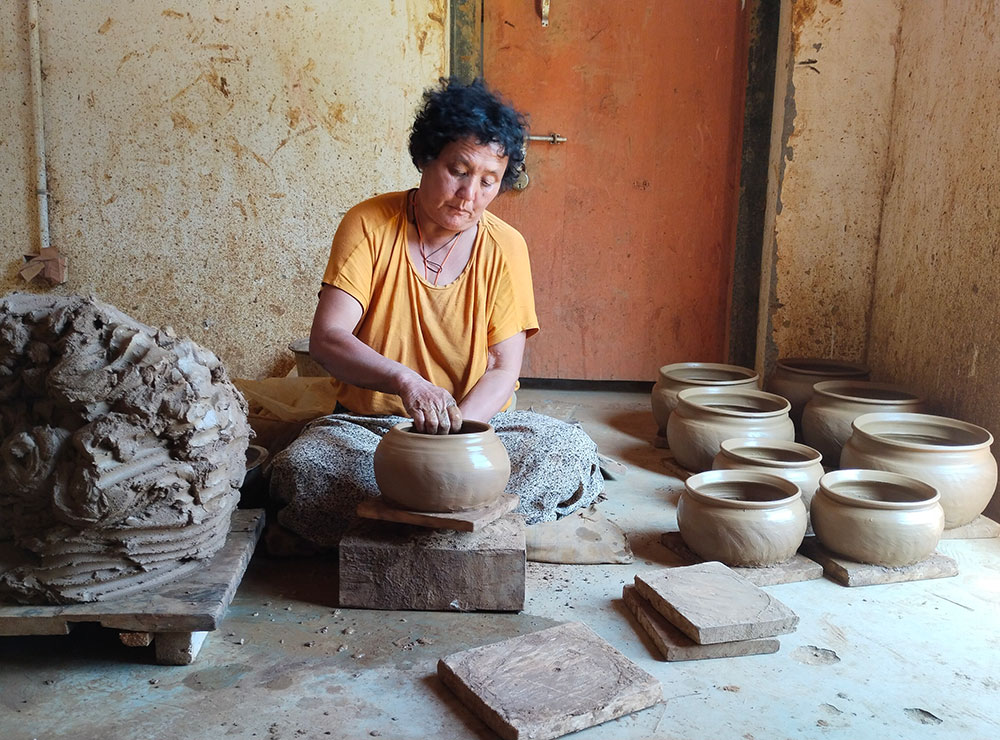… future of pottery rests in the hands of two women
Neten Dorji
Gangzur village in Lhuentse is renowned for its pottery (Dza-zo), a craft whose origins are known to only a few in the dzongkhag. The art has long been associated with the people of Gangzur in Lhuentse.
However, there are only three artisans in Lhuentse, all known for their exceptional skills. The master artisans, potters, have sustained their livelihoods through the craft over three generations.
Fifty-two-year-old Aum Zangmo, the descendant of a master artisan Kuenzang Wangmo, who passed away around three decades ago, is a key figure in the village. Aum Zangmo along with her friend Tshewang Choden, learnt their skills from their ancestors, making them third-generation artisans.
Aum Zangmo, busy at her workshop about 5km away from Lhuentse town, diligently crafts pots, continuing a tradition passed down through generations. She completed making a coarse pot to give a rough shape.
“This is what my mother did after inheriting the skill from my grandmother Kuenzang Wangmo. My grandmother learned from her mother,” she said.
Potters were historically popular because villagers predominantly used these pots for cooking, ranging from rice and curry to stew and alcohol. Aum Zangmo learned the craft by observing her mother, and the pot-making process is labour-intensive.
Aum Zangmo painstakingly creates about 25 pots of different designs, from small teacups for burning incense to large pots used to brew ara (local liquor). The types of pots made by Aum Zangmo are unique compared to those made in western dzongkhags and Trongsa.
Their quality and manual shaping contribute to their higher price. She knows the names of all pot shapes, with Lenka, used to brew ara, considered the most expensive, followed by Nachen ma, the pot used to make curry. Throzoma, Waley, and Dhophangla are common and more affordable pots.
People from other parts of the country and foreigners who visit the village also buy these products. Tarayana Foundation, for instance, purchases pots from Gangzur village every month.
Two decades ago, Zangmo sold five pots of any size for just Nu 1 until dzongkhag officials advised her to raise the price. “We now sell a medium pot for Nu 300 and a large one for Nu 500,” said Zangmo. “In a month, we earn between Nu 30,000 and Nu 40,000.”
During winter or when there is no work in the fields, the artisans dig red and yellow sandy clay above their homes and manually create earthen pots without the use of a spinning lathe or machine.
Once stones and granules are removed from the clay, it is kneaded and beaten into dough. The pots are shaped on a thatched wooden plank. The inside of the clay ball is gouged out, and the rough shell is left to dry inside the room. The pots are then fired to make them firm and durable.
The burning process is crucial, and the pots are heated gently until they turn black in colour. Obtaining permits to get firewood is not easy and requires seeking permits from forest offices, a time-consuming process, according to Zangmo. She expressed gratitude if forest officials could allow them to cut trees from the community forest.
The people of Gangzur have no precise knowledge of how old the pottery tradition is, but it is believed that not long ago, people from eight gewogs in Lhuentse used earthen pots for cooking, storing water, and brewing ara.
Locals believe that this craft proliferated on a large scale during the time of Thangtong Gyalpo. It is also thought that pottery was first practised in Gangzur in Lhuentse, Ringpung in Paro, Wangbama in Thimphu, and Shar Goenkha in Wangdue Phodrang.


